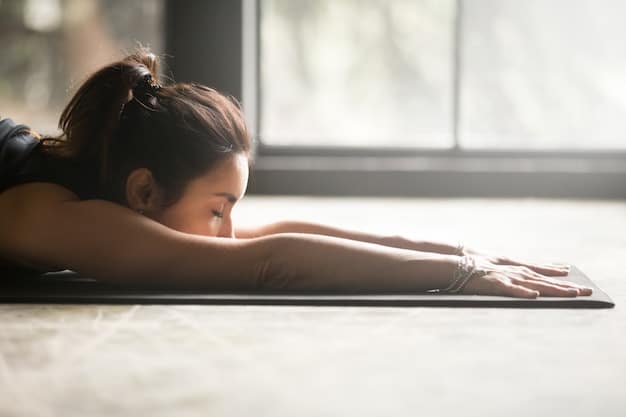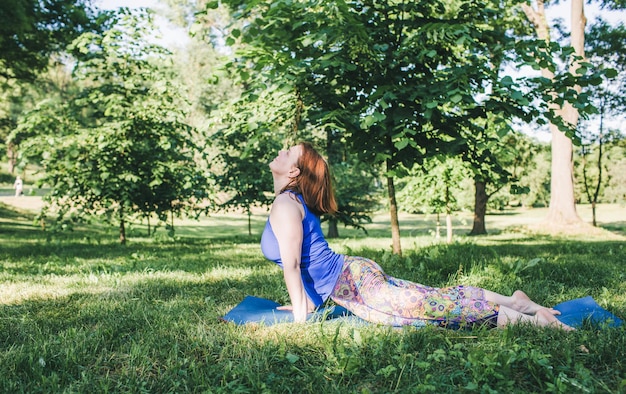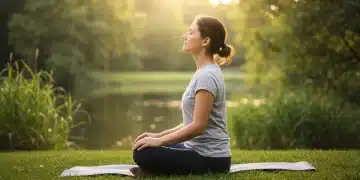Yoga for Stress Reduction: Lower Cortisol in 20 Minutes

Yoga for Stress Reduction offers a practical, evidence-based approach to managing stress by decreasing cortisol levels with only 20 minutes of consistent daily practice, making it an accessible and effective tool for mental and physical well-being.
Feeling overwhelmed by stress? Discover how just 20 minutes of daily Yoga for Stress Reduction: Discover How 20 Minutes of Daily Practice Can Lower Cortisol Levels by 12% can significantly lower your cortisol levels and improve your overall well-being.
The Science Behind Yoga and Stress Reduction
Yoga has long been recognized for its stress-reducing properties, but what does the science say? Understanding the physiological mechanisms behind how yoga impacts stress can provide a deeper appreciation for its benefits. It’s not just about stretching; it’s about influencing your body’s stress response.
How Yoga Affects the Nervous System
Yoga practices, particularly those involving deep breathing and mindful movement, can influence the autonomic nervous system. This system controls involuntary functions like heart rate, digestion, and the body’s stress response.
The Role of Cortisol in Stress
Cortisol, often termed the “stress hormone,” is released by the adrenal glands in response to stress. Chronically elevated cortisol levels can lead to various health problems, including anxiety, depression, and impaired immune function.
- Yoga helps balance the nervous system, shifting it from a sympathetic (fight or flight) to a parasympathetic (rest and digest) state.
- Regular yoga practice can lower baseline cortisol levels, making you more resilient to stress.
- Specific yoga poses and breathing techniques can directly stimulate the vagus nerve, which plays a critical role in regulating heart rate and promoting relaxation.
By engaging in regular yoga, you’re essentially training your body to manage stress more effectively. The combination of physical postures, controlled breathing, and mindfulness helps to regulate the nervous system and keep cortisol levels in check.

Yoga Poses for Immediate Stress Relief
Certain yoga poses are particularly effective at providing immediate stress relief. These poses can be incorporated into a short 20-minute routine, offering a quick and accessible way to calm the mind and body.
Child’s Pose (Balasana)
Child’s pose is a gentle resting posture that encourages relaxation and surrender. It helps to calm the mind, relieve tension in the back and shoulders, and promote a sense of grounding.
Forward Fold (Uttanasana)
Standing forward fold allows the head to be below the heart, which can have a calming effect on the nervous system. It also stretches the hamstrings and lower back, releasing physical tension.
- Legs-Up-the-Wall Pose (Viparita Karani): This pose is incredibly relaxing and can help reduce swelling in the legs and feet.
- Corpse Pose (Savasana): The ultimate relaxation pose, Savasana allows the body to fully rest and integrate the benefits of the practice.
- Cat-Cow Pose (Marjaryasana to Bitilasana): Gentle spinal movements can release tension and promote relaxation.
These poses are just a starting point, and you can adapt them to suit your individual needs and preferences. The key is to focus on your breath and allow yourself to fully relax into each posture.
Breathing Techniques (Pranayama) for Stress Reduction
Breathwork, or pranayama, is an integral part of yoga and a powerful tool for managing stress. Specific breathing techniques can directly influence the nervous system, promoting relaxation and reducing anxiety. These techniques are easy to learn and can be practiced anywhere, anytime.
Diaphragmatic Breathing (Belly Breathing)
Diaphragmatic breathing involves deep, slow breaths that engage the diaphragm. This type of breathing stimulates the vagus nerve and promotes a sense of calm.
Alternate Nostril Breathing (Nadi Shodhana)
Alternate nostril breathing is a balancing technique that helps to calm the mind and reduce anxiety. It involves alternately closing one nostril while breathing through the other.
The science behind it shows that:
- Breath control is key to managing stress hormones.
- Longer exhales than inhales help switch the nervous system from sympathetic (stress) to parasympathetic (relaxation) mode.
- Consistent practice improves heart rate variability, a marker of stress resilience.
Incorporating these breathing techniques into your daily routine, even for just a few minutes, can make a significant difference in your stress levels. Experiment with different techniques to find what works best for you.
Creating a 20-Minute Daily Yoga Routine
Consistency is key when it comes to reaping the stress-reducing benefits of yoga. Creating a simple 20-minute daily routine can make yoga a sustainable part of your life. The routine should be designed to address both physical tension and mental stress.
Warm-Up (5 minutes)
Start with gentle movements to warm up the body, such as neck rolls, shoulder circles, and spinal twists. This helps to increase blood flow and prepare the muscles for deeper stretches.
Core Poses (10 minutes)
Incorporate a selection of stress-relieving poses, such as child’s pose, forward fold, and cat-cow pose. Hold each pose for several breaths, focusing on your breath and releasing any tension.
Here are some guidelines for a 20 minute session:
- Ensure the session is in a quiet place away from distractions.
- Remember to breathe deeply during the routine.
- Consistent practice improves outcomes.
Adapt the routine to match your needs, and don’t be afraid to switch things up as you progress. The goal is to create a practice that you enjoy and that supports your overall well-being.

Mindfulness and Meditation in Yoga for Stress Reduction
Mindfulness and meditation are integral components of yoga that enhance its stress-reducing effects. Cultivating mindfulness involves paying attention to the present moment without judgment, while meditation provides a structured approach to calming the mind. Integrating these practices into your yoga routine can deepen your experience and help you manage stress more effectively.
Mindful Movement
During your yoga practice, focus on the sensations in your body and the rhythm of your breath. This helps to bring your attention to the present moment and away from distracting thoughts.
Guided Meditation
Follow a guided meditation to help quiet the mind and promote relaxation. There are many free guided meditations available online that focus on stress reduction and emotional well-being.
The studies suggest:
- Mindfulness anchors you in the present moment, reducing intrusive thoughts.
- Meditation helps to clear the mind and to promote relaxation.
- Regular practice fosters emotional resilience.
By cultivating mindfulness and incorporating meditation into your yoga routine, you can train your mind to be more resilient to stress and cultivate a greater sense of inner peace.
Lifestyle Changes to Complement Your Yoga Practice
While yoga can be a powerful tool for stress reduction, it’s most effective when combined with other healthy lifestyle choices. These choices work synergistically to support your overall well-being and enhance the benefits of your yoga practice.
Healthy Diet
Nourish your body with a balanced diet rich in fruits, vegetables, whole grains, and lean protein. Avoid processed foods, sugary drinks, and excessive caffeine, as these can exacerbate stress.
Regular Exercise
In addition to yoga, engage in other forms of exercise that you enjoy, such as walking, running, swimming, or dancing. Exercise helps to release endorphins, which have mood-boosting effects.
Incorporating these lifestyle changes alongside your yoga practice can create a holistic approach to stress management:
- Limit screen time before bed.
- Build a supportive social network.
- Hydrate and eat well.
Making these small but significant changes can have a profound impact on your overall well-being, helping you to better manage stress and live a more fulfilling life.
| Key Point | Brief Description |
|---|---|
| 🧘♀️ Yoga’s Impact | Lowers cortisol effectively with consistent practice. |
| 🌬️ Breath Control | Pranayama balances the autonomic nervous system. |
| ⏱️ Daily Routine | A 20-minute regimen enhances well-being. |
| 🌱 Lifestyle Synergies | Healthy habits amplifies yoga’s stress relief. |
Frequently Asked Questions
▼
Many individuals report feeling reduced stress and increased relaxation after just one yoga session, with significant reductions in cortisol levels after consistent practice.
▼
The best time for yoga depends on individual preferences. Morning sessions can energize your day, while evening sessions help unwind before sleep. Consistency is key.
▼
No special equipment is needed to start yoga. While a yoga mat can enhance comfort and stability, you can begin with just a comfortable space to practice.
▼
Yes, yoga is shown to help with anxiety, depression, and even PTSD, among other mood imbalances. Yoga can encourage healing and relaxation for improved emotional well-being.
▼
Always consult with a healthcare professional before starting yoga, especially if you have physical limitations. Modify poses as needed and listen to your body.
Conclusion
Incorporating Yoga for Stress Reduction: Discover How 20 Minutes of Daily Practice Can Lower Cortisol Levels by 12% into your daily routine can profoundly impact your well-being. The combination of physical postures, breath control, and mindfulness offers a holistic approach to managing stress and enhancing overall quality of life.





